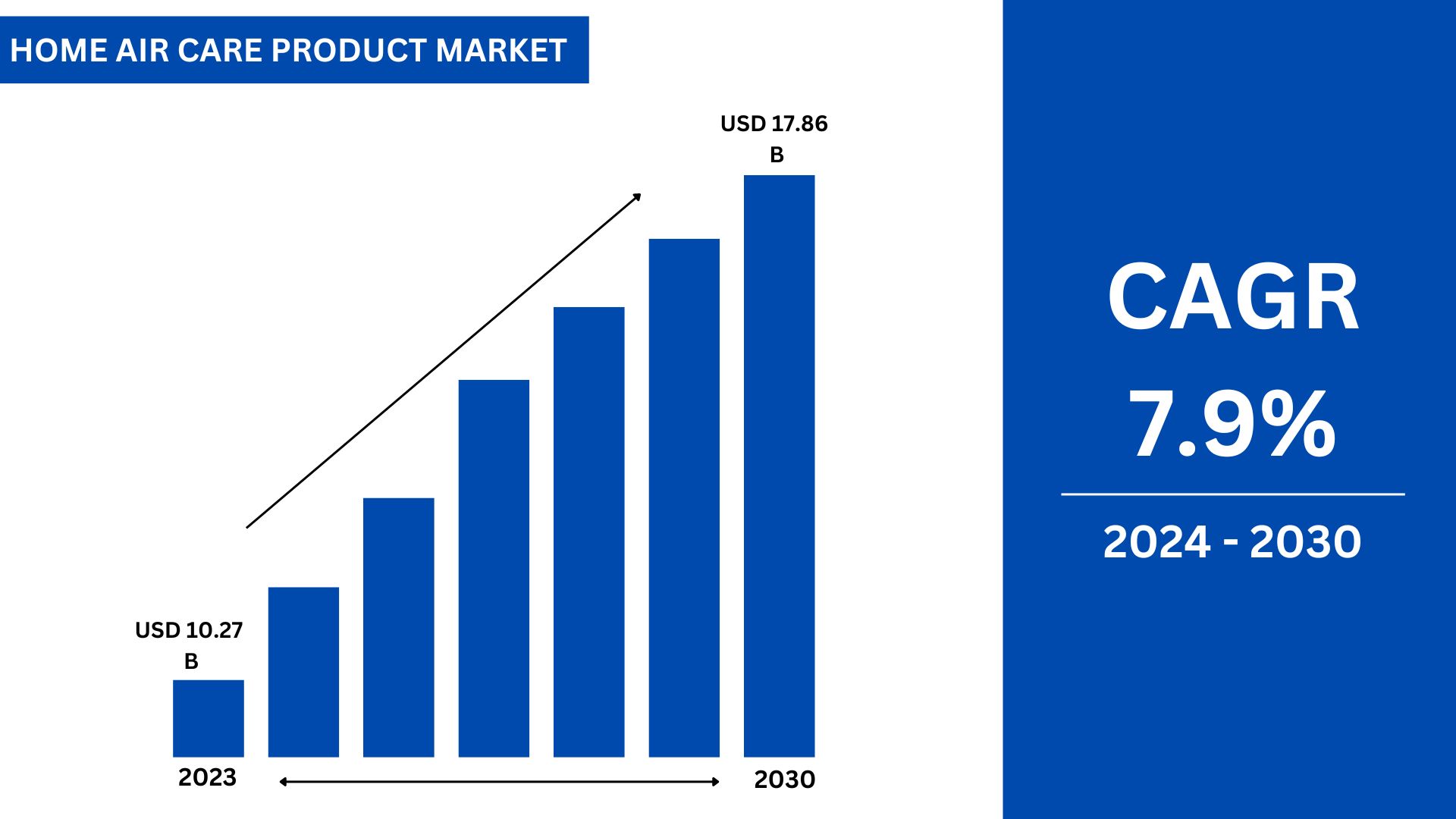TOP CATEGORY: Chemicals & Materials | Life Sciences | Banking & Finance | ICT Media

Download Report PDF Instantly
Report overview
Market Value Growth: The market witnessed significant growth from 2023 to 2030, with its value increasing from USD 10.27 billion to a projected USD 17.86 billion. This indicates a substantial expansion in the demand for home air care products over the forecast period.
Compound Annual Growth Rate (CAGR): The compound annual growth rate (CAGR) of 7.9% reflects the steady and consistent growth trajectory of the market during the forecast period. This indicates sustained demand and increasing adoption of home air care products globally.
Consumer Awareness and Health Concerns: Growing awareness among consumers about indoor air quality and its impact on health is likely to be a significant driver of market growth. Concerns about allergens, pollutants, and airborne pathogens in indoor environments are driving the demand for air care solutions.
Technological Advancements: Innovation in product formulations and technologies is expected to drive market growth. Manufacturers are likely to focus on developing advanced air purification systems, smart home integration, and environmentally friendly products to meet evolving consumer preferences.
Changing Lifestyles and Urbanization: Urbanization and changing lifestyles, characterized by spending more time indoors, are contributing to the demand for home air care products. As people spend a considerable amount of time indoors, especially in urban areas, they are increasingly seeking solutions to maintain clean and fresh indoor air.
Market Segmentation: The market is likely to be segmented based on product types such as air fresheners, air purifiers, and others. Different consumer preferences and needs may drive the demand for specific types of products within the home air care segment.
Regional Dynamics: Market growth may vary across regions due to differences in environmental regulations, consumer preferences, and economic factors. Emerging economies with rising disposable incomes and increasing urbanization rates may present lucrative opportunities for market expansion.
Environmental Concerns and Regulations: Environmental sustainability concerns and stringent regulations regarding emissions and product ingredients are likely to influence product development and marketing strategies within the home air care market.
Competitive Landscape: The market is expected to be competitive, with key players focusing on product innovation, strategic partnerships, and mergers and acquisitions to gain a competitive edge and expand their market presence.
COVID-19 Impact: The COVID-19 pandemic may have accelerated market growth as consumers became more conscious about indoor air quality and hygiene. Increased emphasis on respiratory health and hygiene practices may continue to drive demand for home air care products beyond the pandemic.
The USA market for Global Home Air Care Product market is estimated to increase from USD million in 2023 to reach USD million by 2030, at a CAGR during the forecast period of 2023 through 2030.
The China market for Global Home Air Care Product market is estimated to increase from USD million in 2023 to reach USD million by 2030, at a CAGR during the forecast period of 2023 through 2030.
The Europe market for Global Home Air Care Product market is estimated to increase from USD million in 2023 to reach USD million by 2030, at a CAGR during the forecast period of 2023 through 2030.

Report Overview
This report provides a deep insight into the global Home Air Care Product market covering all its essential aspects. This ranges from a macro overview of the market to micro details of the market size, competitive landscape, development trend, niche market, key market drivers and challenges, SWOT analysis, value chain analysis, etc.
The analysis helps the reader to shape the competition within the industries and strategies for the competitive environment to enhance the potential profit. Furthermore, it provides a simple framework for evaluating and accessing the position of the business organization. The report structure also focuses on the competitive landscape of the Global Home Air Care Product Market, this report introduces in detail the market share, market performance, product situation, operation situation, etc. of the main players, which helps the readers in the industry to identify the main competitors and deeply understand the competition pattern of the market.
In a word, this report is a must-read for industry players, investors, researchers, consultants, business strategists, and all those who have any kind of stake or are planning to foray into the Home Air Care Product market in any manner.
Global Home Air Care Product Market: Market Segmentation Analysis
The research report includes specific segments by region (country), manufacturers, Type, and Application. Market segmentation creates subsets of a market based on product type, end-user or application, Geographic, and other factors. By understanding the market segments, the decision-maker can leverage this targeting in the product, sales, and marketing strategies. Market segments can power your product development cycles by informing how you create product offerings for different segments.
Key Company